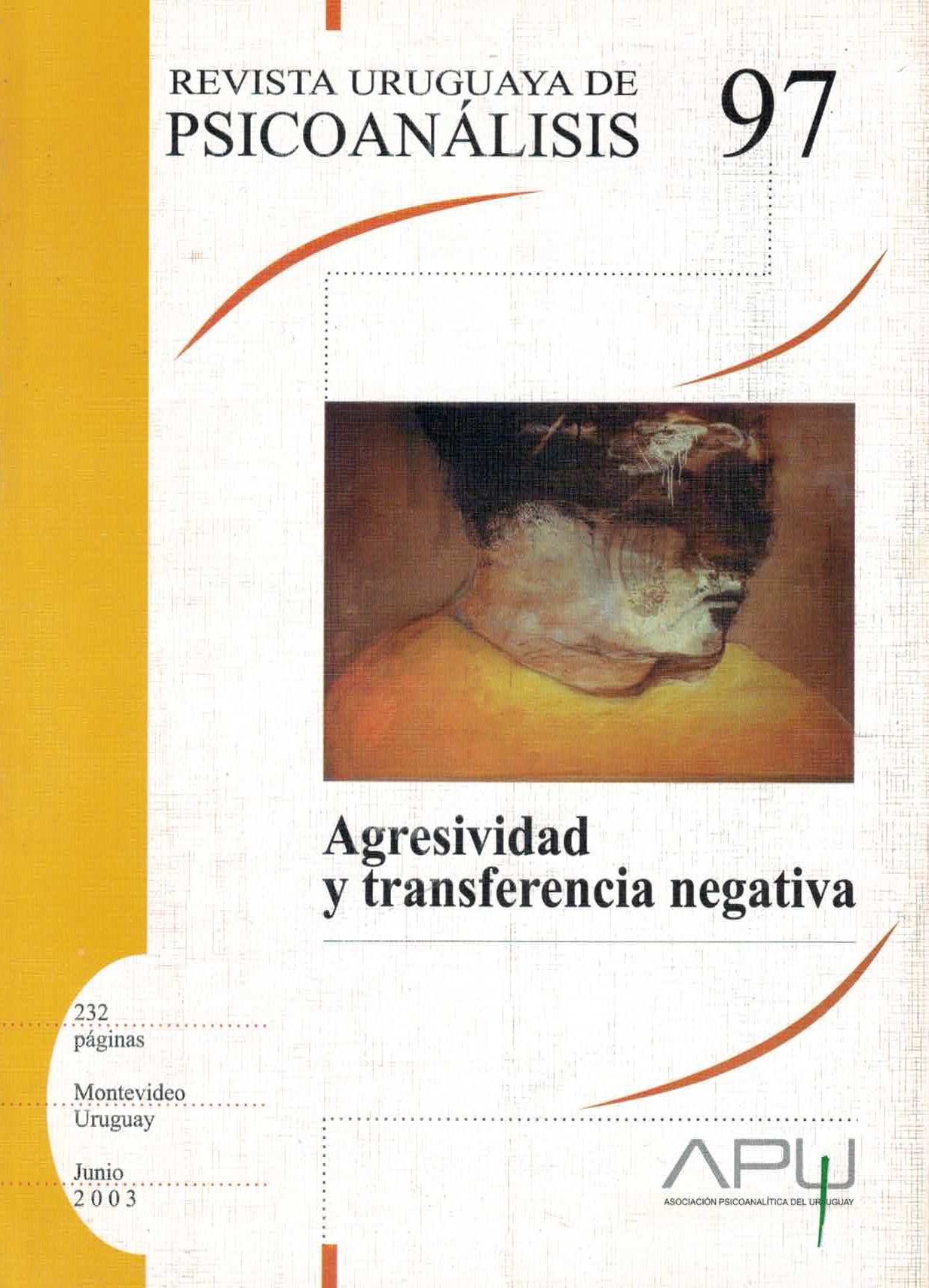Aggression and Negative Transfer in the Context of Attachment Theory and Reflective Function
Keywords:
agresividad, agresión, transferencia negativa, apego, intersubjetividad, psicoterapia psicoanalítica, niño, material clínicoAbstract
The purpose of this piece of work is to reflect on the contribution of the developments in the theory of attachment: emotional adjustment, glimmer of emotions (Gergely and Watson) and reflexive function (Fonagy and Target) as from a clinical situation of aggressiveness and negative transference. The first session of the analysis of an eight year old child is brought up as an example.
The patient displays different aggressive situations, some at the service of life (Eros), others at the service of death (Thanatos) and some others as a way of preserving the “self”. In the context of the attachment theory, aggressiveness has a defensive function protecting the “self” representation. It plays a necessary role in the structuring of the psyche and in the display of the normal
exploratory and search impulses that are necessary to maintain a safe bond.
Downloads
References
ALTMANN M. & GRIL S. et al. (2000): “Los duelos. Sus efectos en el apego y la narrativa”. Publicación Asociación Psicoanalítica del Uruguay.
ALTMANN de LITVAN, M. (1987): Sobre la experiencia del dolor psíquico y algunas de sus transformaciones. Trabajo de miembro adherente APU. Inédito.
ALTMANN de LITVAN, M. et al.(2002): Juego y regulación afectiva. Presentación en el XXIV Congreso de FEPAL, Montevideo, 2002.
ALTMANN de LITVAN, M. & LUZARDO, M. (2003): Microanalytic study of relationship patterns in psychotherapeutic process through verbal and nonverbal indicators using mathematical models. Single case study. Presentado en: Sandler Research Conference, Londres, Marzo 2003.
BION, W. (1975): “Aprendiendo de la experiencia”. Ed. Paidos.
BLATT, S. and BLASS, R. (1990): Attachment and Separateness—A Dialectic model of the Products and processes of development through the life cycle. En: Psychoanal. St. of the Child 46:107-127.
BLEICHMAR, H. Del apego al deseo de intimidad: las angustias del desencuentro. En: Revista Aperturas Psicoanalíticas, Julio 1999.
BOWLBY, J.(1968): La Pérdida Afectiva. Paidos, Barcelona.
———— (1968): La Separación Afectiva. Paidos, Barcelona.
———— (1958): The nature of the child’s tie to his mother. En: Int. J. PsychoAnal., 39: 350-373.
BRETHERTON, I. (1995): The origins of attachment theory: John Bowlby and Mary Ainsworth. En: Attachment Theory, Goldberg, Muir and Kerr Eds. Pp. 45-84
EAGLE, M. (1995): The developmental perspectives of attachment and psychoanalytic theory. En: Attachment Theory, Goldberg, Muir and Kerr Eds. Pp. 123-152.
ETCHEGOYEN, H. (1986): Los fundamentos de la técnica psicoanalítica. Amorrortu Editores, Bs.As.
ENGEL, G. (1971): Attachment behaviour, object relations and the dynamiceconomic points of view–critical review of Bowlby’s attachment and
loss 1. En: International J. Psychoanal, 52: 183-196.
FONAGY, P., STEELE, M., STEELE, H., LEIGH, T., KENNEDY, R., MATOON, G. and TARGET, M. (——): Attachment, the reflective self and Borderline
states.
FONAGY, P, MORAN, G. and TARGET, M. (1993): Aggression and the Psychological Self. Int. Journal of Psychoanalysis 74, 471-485.
FONAGY, P. y TARGET, M. (1996): Jugando con la realidad I. Teoría de la mente y el desarrollo normal de la realidad psíquica. En: Libro Anual de Psicoanálisis XII. Publicado por la Editora Escuta Ltd. San Pablo, Brasil, pp. 11-26.
———— (1996): Jugando con la realidad II. El desarrollo de la realidad psíquica desde una perspectiva teórica. En: Libro de Psicoanálisis XII.
Publicado por la Editora Escuta Ltd. San Pablo, Brasil, pp. 65-86.
———— (1996): Jugando con la realidad III. La persistencia de la realidad psíquica dual en pacientes borderline. Trad. Juan Manuel Pedreyra.
FONAGY, TARGET, STEELE & STEELE (1998): Manual de función reflexiva. Trad. Susana Quiroga. FONAGY, P. (2001a): El uso de múltiples métodos para hacer al psicoanálisis relevante en el nuevo milenio. En: Psicoanálisis Focos y Aperturas. Psicolibros, Librería Editorial. Traducción Denise Defey.
———— (2001): Attachment and Psychoanalysis. Other Press London.
FONAGY, P., GERGELY, G., JURIST, E. y TARGET, M. (2002): Affect regulation, mentalization and the development of the Self. Other Press London.
FONAGY, P. & TARGET, M. (2003): Psychoanalytic theories. Perspectives from developmental psychopathology. Whurr Publishers, London.
GERGELY, G. & WATSON, J. (1996): The Social biofeedback theory of parental affect- mirroring. International Journal of Psychoanalysis, 77: 1181-1212.
GRIL, S., ALTMANN, M., MERGENTHALER (1998): From language to behavior. The Cycles Model as a guide. Paper in Panel of the 29th annual
meeting of the Society for Psychotherapy Research, Snowbird, Utah.
———— (1999): Attachment and Narratives. Paper in Panel of the 30th annual meeting of the Society for Psychotherapy Research, Braga, Portugal.
HOLMES, J. (1995): Something there is that doesn’t love a wall. John Bowlby Atthachment theory and Psychoanalysis. En: Attachment Theory, Goldberg, Muir and Kerr Eds. Pp. 19-44.
———— (2001): The search for the secure base. Attachment theory and Psychotherapy. Brunner-Routledge, USA.
LIOTTI, G. (1995): Disorganized/disoriented attachment in the psychotherapy of dissociative disorders. En: Attachment Theory, Goldberg, Muir and Kerr Eds.Pp. 343-366.
MAIN, M. (1997): Recent studies in attachment, attachment theory. Ed. Goldberg, Muir y Kerr, New York.
SILVERMAN, D. (2000): Sexuality and attachment: A passionate relationship or a marriage of convenience? En: The Psychoanalytic Quarterly, vol. LXX, 2:325-
STERN, D. (1997): La Constelación Maternal. La Psicoterapia en las Relaciones Entre Padres e Hijos. Paidos, Barcelona.
———— (1985): The Interpersonal World of the Infant. Basic Books, Inc. Publishers/New York.



 This work is licensed under a
This work is licensed under a 